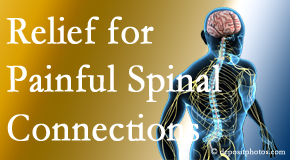Dr. Paulette Hugulet, DC, LLC Knows Well the Spine and Its Connections
Nerves. Discs. Muscles. What connects them all? The spine! And back pain is a complex condition often involving all these components. Your La Grande chiropractor at Dr. Paulette Hugulet, DC, LLC values every one of these spinal elements. Your La Grande chiropractor pays great attention to each of these spinal elements. Your La Grande chiropractor reduces La Grande back pain and neck pain related to these spinal elements with gentle chiropractic services and Cox® Technic at Dr. Paulette Hugulet, DC, LLC.
THE SPINE
The spine is the body’s support system. The spine connects everything! The spine’s bones – called vertebrae – join ligaments, muscles and discs to form this support system. 25 intervertebral discs separate the usual 33 vertebrae. Three parts form each disc – the gel-like, water/collagen-composed nucleus pulposus contained and held in place by the collagenous annulus fibrosus and two endplates on top and bottom that protect and allow nutrients into the nucleus. The disc keeps the spine flexible and strong. (1) Seemingly off-topic but really not as these findings demonstrate just how connected the spine is, more articles surface about the importance of diaphragm training for muscle relaxation like the hamstring muscles. In a recent study, this training is documented to boost the thickness of lumbar spine stabilizing muscles, transverse abdominis and lumbar multifidus muscles. (2) Dr. Paulette Hugulet, DC, LLC is astounded by what diaphragm-focused treatment does for such muscles. It all goes back to how intricately the spine is designed and connected! Interesting! Dr. Paulette Hugulet, DC, LLC enjoys working La Grande chiropractic patients’ spines every day!
NERVES
Spinal nerves intertwine their ways in the spine, collecting and sending impulses from head to toe. The superior gluteal nerve winds its ways through the lower pelvis by the L4, L5 and S1 nerve roots in the sacral plexus. It supplies nerves to the gluteus medius, gluteus minimum and tensor fasciae latae muscles. If injured, it often causes an obviously different walking and standing gait because of the gluteus medius muscle paralysis it causes. (3) Dr. Paulette Hugulet, DC, LLC back pain patients understand how touchy these spinal nerves are and so does Dr. Paulette Hugulet, DC, LLC.
MUSCLES
The spine depends on muscles to maintain its connections. The psoas muscle passes along both sides of the spinal vertebral column down to the pelvis. It’s deep and originates at the lumbar vertebrae, L1-L4, adjoining much more - the less trochanter of the femur, iliopsoas muscle, psoas major muscle, inconsistent psoas minor muscle, iliac fascia, iliacus muscle, and inguinal ligament – influencing postural function and having an effect on mood and stress disorders as a cause of low back pain. (4) The quadratus lumborum muscle is essential to stability. Its deep, posterior, lateral and interior location around the spine often draws into question its contributing role in back pain. It’s an essential part of the thoracolumbar fascia muscle system as it surrounds the iliac crest, the transverse processes of lumbar spine’s vertebrae and 12th rib. (5) The external oblique muscle is key to balance, preserving the center of gravity, as well as stability. Interestingly, in a research study of women with chronic low back pain, stability exercises and balance exercises involving the external oblique muscle improved erector spinae muscle activity and decreased pain and disability. (6) That is why Dr. Paulette Hugulet, DC, LLC customarily suggests exercise to La Grande back pain patients as part of the chiropractic treatment plan. Do not worry! Dr. Paulette Hugulet, DC, LLC ensures these are simple and helpful for you!
CONTACT Dr. Paulette Hugulet, DC, LLC
Listen to this PODCAST with Dr. Lonny Skjervheim on The Back Doctors Podcast with Dr. Michael Johnson about chiropractic treatment of low back pain with leg pain together using Cox® Technic spinal manipulation.


